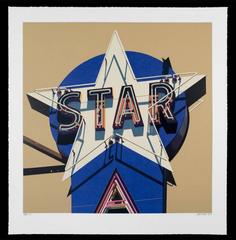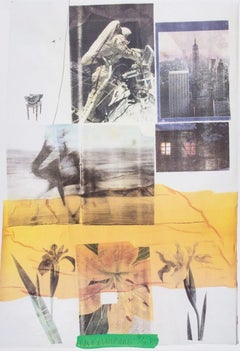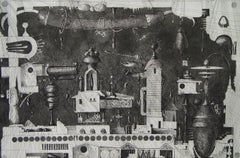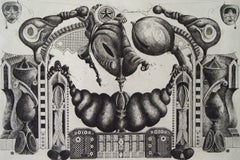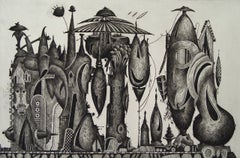Large Still-life Prints
to
100
1,697
800
984
647
324
Overall Width
to
Overall Height
to
287
63
47
28
24
8
5
4
4
3
2
2
1
117
30
24
19
13
4
1
259
383
1
3
1
8
19
74
82
36
2
335
270
42
119
111
107
75
62
37
36
33
26
25
23
21
20
19
16
15
14
13
13
12
262
188
181
179
175
102
176
518
115
Size: Large
Star, from American Signs Portfolio
Located in New York, NY
ROBERT COTTINGHAM
Star, from American Signs portfolio, 2009
screenprint in colors, on wove paper, with full margins,
40 1/8 x 39 1/8 in (101.9 x 99.4 cm)
signed, dated `2009' and numbered edition of 100 in pencil
--
Robert Cottingham
B. 1935, BROOKLYN, NEW YORK
Born in 1935 in Brooklyn, Robert Cottingham is known for his paintings and prints of urban American landscapes, particularly building facades, neon signs, movie marquees, and shop fronts. After serving in the U.S. Army from 1955 through 1958, he earned a BFA at Pratt Institute, Brooklyn, in 1963. Cottingham began his professional artistic career as an art director for the advertising firm Young and Rubicam in the early 1960s. Although he is typically associated with Photorealism, Cottingham never considered himself a Photorealist, but rather a realist painter working in a long tradition of American vernacular scenes. In this respect, his work often draws parallels to a number of American painters such as Stuart Davis, Charles Demuth, Edward Hopper, and Charles Sheeler.
Cottingham’s interest in the intersections of art and commerce derive from his career as an adman and the influence of Pop art. Many of his paintings convey an interest in typography and lettering, as well as an awareness of the psychological impact of certain isolated words and letters. In his facades, techniques from advertising, namely cropping and enlarging, often produce words of enigmatic or comical resonance such as “Art,” “Ha,” or “Oh.” Cottingham’s enlarged sense of scale is reminiscent of James Rosenquist’s work, while his interest in text suggests the influence of Robert Indiana and Jasper Johns. In general, Cottingham viewed his work as continuing the legacy of Pop artists such as Andy Warhol, who also had a background in advertising.
In 1964, Cottingham relocated to Los Angeles for work. There, inspired by the drastically different environment of the West Coast metropolis, he began to commit seriously to painting. Fascinated by Hollywood’s exaggerated glitz and the downtrodden atmosphere of the downtown, Cottingham saw in Los Angeles the relics of a bygone commercial heyday and desired to capture its kitschy and uncanny atmosphere, bathed in the near perpetual sunlight of Southern California.
In 1968, Cottingham ended his advertising career in order to devote all his time to painting. In the late 1960s, he started using photography in his practice, first as an initial reference point for his process. After selecting a photograph, he translates it into black-and-white drawings by projecting the image onto gridded paper...
Category
Early 2000s Photorealist More Prints
Materials
Screen
American Signs portfolio
Located in New York, NY
ROBERT COTTINGHAM
American Signs portfolio, 2009
The complete set of twelve screenprints in colors, on wove paper, with full margins, 40 1/8 x 39 1/8 in (101.9 x 99.4 cm)
all signed, dated `2009' and numbered edition of 100 in pencil, published by Exhibit A Fine Art and Editions and American Images Atelier, New York, all in excellent condition, contained in original gray silk-covered box with artist and title embossed with gold foil.
Robert Cottingham
B. 1935, BROOKLYN, NEW YORK
Born in 1935 in Brooklyn, Robert Cottingham is known for his paintings and prints of urban American landscapes, particularly building facades, neon signs, movie marquees, and shop fronts. After serving in the U.S. Army from 1955 through 1958, he earned a BFA at Pratt Institute, Brooklyn, in 1963. Cottingham began his professional artistic career as an art director for the advertising firm Young and Rubicam in the early 1960s. Although he is typically associated with Photorealism, Cottingham never considered himself a Photorealist, but rather a realist painter working in a long tradition of American vernacular scenes. In this respect, his work often draws parallels to a number of American painters such as Stuart Davis, Charles Demuth, Edward Hopper, and Charles Sheeler.
Cottingham’s interest in the intersections of art and commerce derive from his career as an adman and the influence of Pop art. Many of his paintings convey an interest in typography and lettering, as well as an awareness of the psychological impact of certain isolated words and letters. In his facades, techniques from advertising, namely cropping and enlarging, often produce words of enigmatic or comical resonance such as “Art,” “Ha,” or “Oh.” Cottingham’s enlarged sense of scale is reminiscent of James Rosenquist’s work, while his interest in text suggests the influence of Robert Indiana and Jasper Johns. In general, Cottingham viewed his work as continuing the legacy of Pop artists such as Andy Warhol, who also had a background in advertising.
In 1964, Cottingham relocated to Los Angeles for work. There, inspired by the drastically different environment of the West Coast metropolis, he began to commit seriously to painting. Fascinated by Hollywood’s exaggerated glitz and the downtrodden atmosphere of the downtown, Cottingham saw in Los Angeles the relics of a bygone commercial heyday and desired to capture its kitschy and uncanny atmosphere, bathed in the near perpetual sunlight of Southern California.
In 1968, Cottingham ended his advertising career in order to devote all his time to painting. In the late 1960s, he started using photography in his practice, first as an initial reference point for his process. After selecting a photograph, he translates it into black-and-white drawings by projecting the image onto gridded paper...
Category
Early 2000s American Realist Still-life Prints
Materials
Screen
Untitled
Located in New York, NY
Created by Robert Rauschenberg as a color screenprint and photo-lithograph in 1989, Untitled measures 39 3/8 x 27 ½ inches (100 x 70 cm), unframed and is hand-signed, dated and numbe...
Category
20th Century Contemporary Still-life Prints
Materials
Lithograph, Screen
Night Shift
By Valton Tyler
Located in Dallas, TX
In The New York Times Arts in America column, Edward M. Gomez wrote of Valton Tyler, "visionary seems the right word for describing his vivid, unusual and technically refined paintin...
Category
1970s Surrealist Still-life Prints
Materials
Rag Paper, Etching, Aquatint
Heritage
By Valton Tyler
Located in Dallas, TX
In The New York Times Arts in America column, Edward M. Gomez wrote of Valton Tyler, "visionary seems the right word for describing his vivid, unusual and technically refined paintin...
Category
1960s Outsider Art Abstract Prints
Materials
Rag Paper, Etching, Aquatint
Freezing Point
By Valton Tyler
Located in Dallas, TX
In The New York Times Arts in America column, Edward M. Gomez wrote of Valton Tyler, "visionary seems the right word for describing his vivid, unusual and technically refined paintin...
Category
1970s Outsider Art Figurative Prints
Materials
Rag Paper, Etching
Flowers FS II.70, 1970
By Andy Warhol
Located in New York, NY
Andy Warhol
Flowers (FS II.70), 1970
silkscreen on paper
36 x 36"
ed. of 250
signed in ball point pen and numbered with a rubber stamp on verso
Category
1960s Pop Art Still-life Prints
Materials
Archival Ink
Blue Sonica Whisper
Located in New York, NY
Blue Sonica Whisper
Category
21st Century and Contemporary Contemporary Abstract Prints
Materials
Archival Ink
Folded Flag
By Mark Adams
Located in San Francisco, CA
Born in Fort Plains, N.Y., Mark Adams (1925 - 2006) went on to attend Syracuse University, but left before graduation to study abstract art in New York with...
Category
1990s Contemporary Prints and Multiples
Materials
Lithograph
